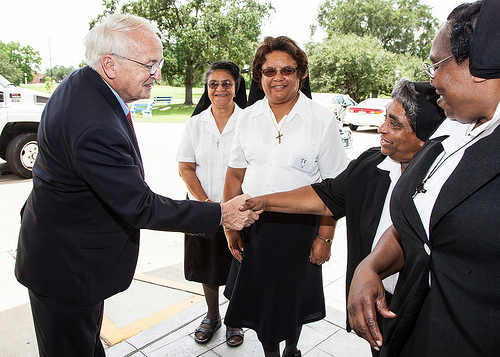
Colorized SEM (scanning electron micrograph) of the foodborne pathogen Salmonella enteritidis. Photo by Jean Guard, ARS.
This post is part of the Science Tuesday feature series on the USDA blog. Check back each week as we showcase stories and news from USDA’s rich science and research profile.
When it comes to microorganisms that contaminate our foods, you may think it’s a veritable jungle out there—but in fact, in the United States, most of the illnesses, hospitalizations and deaths caused by foodborne pathogens come down to 14 bad players. Read more »

Undersecretary Kevin Concannon meets with Sisters of the Holy Family, an order of nuns based in New Orleans.
When a newspaper reporter asked me recently, “What can I tell our readers about the USDA programs,” I told her: “Most of what USDA’s Food and Nutrition Service does is through others.”
As I travel throughout the country, I see how different organizations come together to carry out our mission of putting food on the table for those in need. In concert with FNS’ 15 nutrition assistance programs, hundreds of organizations are working hard every day to create the safety net against hunger that protects Americans. Without fanfare and with little public notice, coalitions of non-profits, religious organizations and groups of volunteers are often the first line of defense against hunger. Read more »
Olga Morales admits she is kind of a workaholic.
Two decades ago, Olga Morales worked inside an egg products plant in Elizabeth, N.J., inspecting food to make sure it was safe for the public to purchase and to eat. Today, after rising through the ranks at the Food Safety and Inspection Service, she works at a desk job in Washington, D.C., where she investigates food safety violations by meat, poultry and egg products companies.
Despite the changes in her work environment between then and now, Olga feels the same excitement when she goes to work every morning as she did 20 years ago. “I am proud of my work, and I want everyone to know that,” she said.
Born and raised in Mayagüez, Puerto Rico, Olga knew when she was 5 years old that she wanted a career where she could help people and “make a difference” in their lives. It was in high school that her interest in science grew and she had the opportunity to do well in her favorite subjects—anything related to science. After earning a Bachelor of Science degree in Medical Technology from the InterAmerican University in Puerto Rico, she began her federal career with the U.S. Department of Defense working as a health technician and held other health-related jobs in the private sector. Read more »
The far northern Maine towns of St. Agatha and Frenchville recognize the value of partnership. So when the aging St. Agatha wastewater treatment plant began to have issues, the towns began to work on a solution. That solution was a mutually beneficial partnership with Frenchville, located only six miles away.
The towns agreed to combine their wastewater treatment system into a single, state-of-the-art facility located in Frenchville. This decision helped both towns to cut costs, while helping to preserve the Saint John River and Long Lake, which is a valuable Salmon hatchery in the area.
The total project cost was $3.2 million, with USDA Rural Development providing $1.1 million to assist with the conversion of the treatment plant to a pumping facility. Other funding partners include the Maine Department of Environmental Protection, and the Maine Department of Economic and Community Development. Read more »
Are you interested in helping shape the future of USDA human nutrition research? What human nutrition-related issues are you interested in? Childhood obesity? The nutrient content of foods? Health promotion and disease prevention? Now’s your chance to let your voice be heard. Be an active participant by visiting our “Idea Space” and sharing your thoughts with us. Your input will help guide us in setting our human nutrition research priorities for the future. Our research helps solves problems that affect Americans’ lives every day. Help us decide which problems should be our priorities.
As USDA’s chief scientific research agency, the Agricultural Research Service (ARS) is leading America towards a better future through agricultural research and information. Now ARS wants your input in planning its human nutrition research program for the next five years. Read more »


